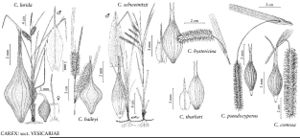Difference between revisions of "Carex comosa"
Proc. Linn. Soc. London 1: 258. 1846.
FNA>Volume Importer |
FNA>Volume Importer |
||
| Line 24: | Line 24: | ||
|elevation=0–700 m | |elevation=0–700 m | ||
|distribution=Ont.;Que.;Ark.;Calif.;Conn.;Del.;Idaho;Ill.;Ind.;Iowa;Maine;Md.;Mass.;Mich.;Minn.;Miss.;N.J.;N.Y.;N.C.;Ohio;Pa.;S.C.;Tenn.;Tex.;Vt.;Va.;Wis.;Mexico. | |distribution=Ont.;Que.;Ark.;Calif.;Conn.;Del.;Idaho;Ill.;Ind.;Iowa;Maine;Md.;Mass.;Mich.;Minn.;Miss.;N.J.;N.Y.;N.C.;Ohio;Pa.;S.C.;Tenn.;Tex.;Vt.;Va.;Wis.;Mexico. | ||
| − | |discussion=<p>Carex comosa is uncommon and local in the west and south of glaciated regions in the east except in some coastal areas.</p><!-- | + | |discussion=<p><i>Carex comosa</i> is uncommon and local in the west and south of glaciated regions in the east except in some coastal areas.</p><!-- |
| − | --><p>Carex comosa rarely forms sterile hybrids with C. pseudocyperus and C. hystericina.</p> | + | --><p><i>Carex comosa</i> rarely forms sterile hybrids with <i>C. pseudocyperus</i> and <i>C. hystericina</i>.</p> |
|tables= | |tables= | ||
|references= | |references= | ||
| Line 49: | Line 49: | ||
|publication year=1846 | |publication year=1846 | ||
|special status= | |special status= | ||
| − | |source xml=https://jpend@bitbucket.org/aafc-mbb/fna-data-curation.git/src/ | + | |source xml=https://jpend@bitbucket.org/aafc-mbb/fna-data-curation.git/src/8f726806613d60c220dc4493de13607dd3150896/coarse_grained_fna_xml/V23/V23_952.xml |
|genus=Carex | |genus=Carex | ||
|section=Carex sect. Vesicariae | |section=Carex sect. Vesicariae | ||
Revision as of 16:12, 18 September 2019
Plants densely to loosely cespitose; rhizomes short, no more than 10 cm. Culms trigonous in cross section, 50–120 cm, scabrous distally. Leaves: basal sheaths pale brown; ligules usually much longer than wide; blades mid to dark green, flat to W-shaped, 5–16 mm wide, glabrous. Inflorescences 4–35 cm; proximal bract 15–85 cm, much longer than inflorescence; proximal (2–)3–6 spikes pistillate, erect or the proximal pendent, cylindric, 12–18 mm thick; terminal staminate or, sometimes, gynaecandrous, androgynous, or mixed. Pistillate scales lanceolate-acuminate, 2.8–12 × 0.4–1 mm, all but the proximal shorter than perigynia, margins ciliate, apex tapering to long scabrous awn. Staminate scales scabrous-awned, sometimes ciliate-margined. Perigynia spreading to reflexed when mature, strongly 14–22-veined, most veins separated by less than 2 times their width, confluent at or proximal to mid beak, tightly investing achene, narrowly elliptic to lanceolate, (4.8–)6.2–8.7 × 1.1–1.8 mm, leathery, apex gradually tapered; beak poorly defined, 2–3.8 mm, bidentate, teeth outcurved, 1.3–2.1(–2.8) mm. Stigmas 3. Achenes pale brown, trigonous, smooth.
Phenology: Fruiting Apr–Jul.
Habitat: Swamps and wet thickets, stream, pond, and lakeshores, depressions in wet meadows, marshes, including freshwater tidal marshes, often in shallow water or on emergent stumps, floating logs, and floating mats of vegetation
Elevation: 0–700 m
Distribution

Ont., Que., Ark., Calif., Conn., Del., Idaho, Ill., Ind., Iowa, Maine, Md., Mass., Mich., Minn., Miss., N.J., N.Y., N.C., Ohio, Pa., S.C., Tenn., Tex., Vt., Va., Wis., Mexico.
Discussion
Carex comosa is uncommon and local in the west and south of glaciated regions in the east except in some coastal areas.
Carex comosa rarely forms sterile hybrids with C. pseudocyperus and C. hystericina.
Selected References
None.
